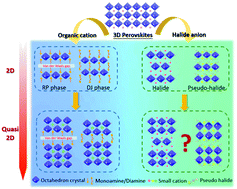Recent progress of anion-based 2D perovskites with different halide substitutions
Abstract
Low-dimensional perovskites have been regarded as the heir of traditional perovskites because of their tailorable structures and the resultant optoelectronic properties as well as the higher stability under ambient conditions, giving them better potential in optoelectronic devices with long term stability. To date, most 2D perovskites are constructed from large organic cations as a spacer, sandwiched between the inorganic octahedron layers to form layered structures. Other than A-site constituent engineering, in recent years, it was reported that the perovskite layers can be divided by suitable X-site components, increasing the possibility of many different 2D perovskite structures and possibly leading to a bright future. In this review, we first digest the latest developments in low dimensional perovskites, including the different phases and the unique optoelectronic properties of 2D perovskites. Subsequently, different approaches to constructing 2D perovskites will be discussed in detail, involving the traditional way of altering A-site cations and the latest way of varying X-site anions. The basic principle of partioning 2D perovskite layers from the X-site constituents will be particularly focused on. The review is aimed at providing readers with an innovative viewpoint for fashioning 2D perovskites and possible future research directions for next generation 2D perovskites. Finally, a conclusion and outlook for future prospects in 2D perovskite structures will also be delivered.



 Please wait while we load your content...
Please wait while we load your content...